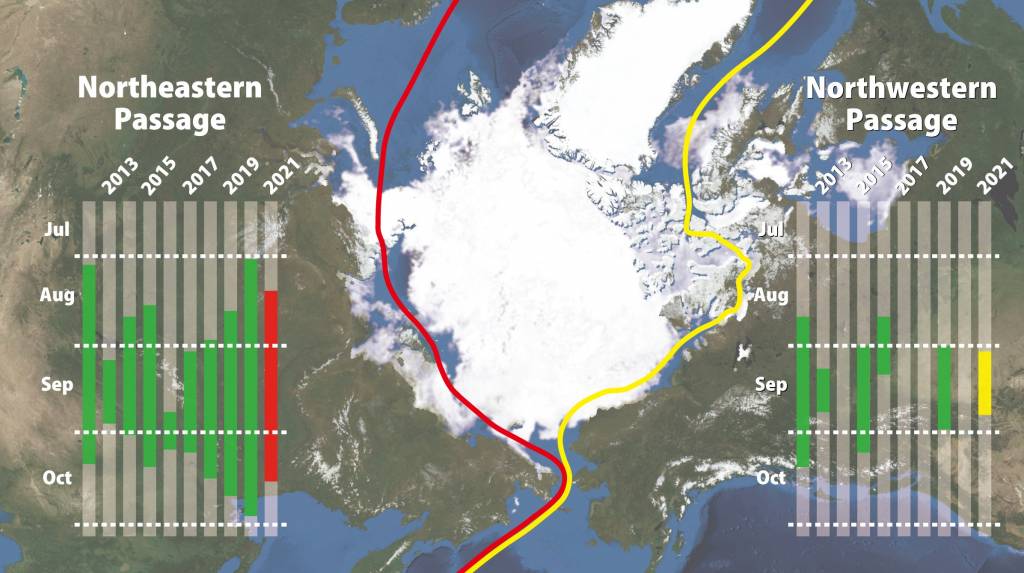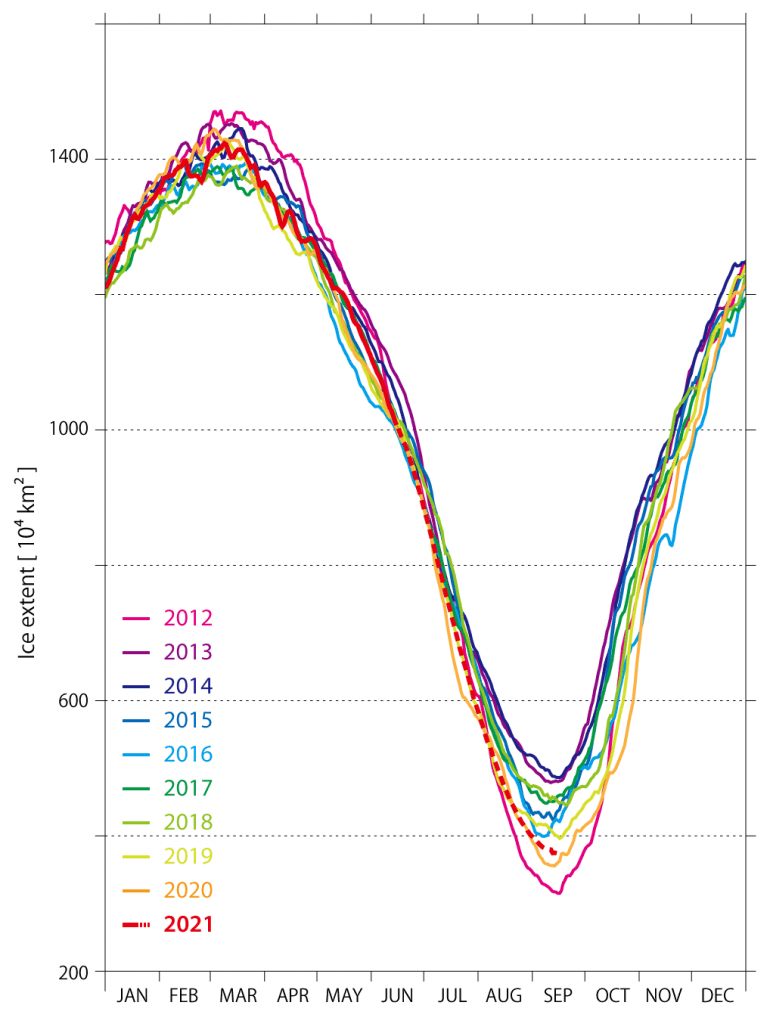News & Press Release
Weathernews announces "Arctic Sea Ice Trends 2021"
Northern Sea Route to open in mid-august; higher temperatures resulting in longer open periods.
Third smallest sea ice area on record expected from global warming
Shipping >Weathernews Inc. Global Ice Center has announced its Arctic Sea ice forecast for 2021. Northern Sea Route (NSR) are expected to be open this summer from mid-August on the Siberian side (Northeast Passage) and from early September on the Canadian side (Northwest Passage). Further, the Arctic Sea ice area is expected to be the third smallest on record.
The impact of global warming has been the most prominent in the Arctic region, with the temperatures rising at a rate approximately three times the global average. This is causing sea ice to melt, allowing the NSR to remain open for longer periods. The Arctic region experienced record-breaking high temperatures last year that included the 38 degrees in Verkhoyansk in northern Siberia, the highest on record for the town. As a result, the routes stayed open last year for the longest period ever of 88 days. Though not as long as last year, the routes are still projected to remain open this year for approximately two months.
The extended sea ice melt season attributable to global warming as well as the reduced travel distance, and hence cost, achievable through the selection of an NSR have contributed to an increase in the regular use of the NSR. In addition, the routes also serve as the main routes for LNG carriers transporting liquefied natural gas produced in the Arctic Sea. Weathernews has been providing its Polar Routeing service since 2011 to support the safe navigation of vessels operating in the Arctic Sea. Weathernews will continue to support the safe navigation of vessels this summer by combining the observation data from its proprietary microsatellite WNISAT-1R with existing satellite images for a more accurate picture of sea ice distribution in the Arctic Sea, where observation data is sparse.

◆Arctic Sea Ice Trends in 2021
In an average year, sea ice area peaks some time during the winter months of February to March, and reaches its lowest point during the summer month of September. Sea ice area peaked on about March 10 this year at 14.2 million km2. Sea ice currently being in the declining phase due to melting, sea ice area as of July 4 is 8.5 million km2. Ice is expected to melt at a rapid rate throughout summer, with sea ice area reaching its minimum for this year at about 3.74 million km2 in mid-September. It will be the third smallest sea ice area recorded since observations began in 1979, falling immediately behind the record for the second smallest area set last year.

* Dotted line after June 2021 indicates predicted values
Table 1: Minimum areas of Arctic sea ice in the summer period
(in ascending order)
Area of Arctic Sea ice extent (yearly minimum value) | ||
*Recorded since 1979, 2021 is a prediction | ||
1st | 3.18 million km2 | 2012 |
2nd | 3.55 million km2 | 2020 |
3rd | 3.74 million km2 | 2021 |
4th | 3.96 million km2 | 2019 |
5th | 4.02 million km2 | 2016 |
Ice-covered areas in the NSR diminish as the ice-free areas (open waters) expand along the Siberian and Alaskan coasts. While areas of open water that began to emerge along the coasts in late May this year are gradually expanding, the ice-covered areas are decreasing at a slightly lower rate compared to the same period last year.
The NSR on the Siberian side (Northeast Passage) is expected to remain open from mid-August to early October. Although shorter than the longest-ever record of 88 days marked last year, the Passage is projected to stay open for approximately two months. Meanwhile, the opening of the route on the Canadian side (Northwest Passage) is anticipated for early September.

Weathernews monitors Arctic Sea ice using its proprietary microsatellite WNISAT-1R launched in 2017. Figure 3 is a satellite image of sea ice around the Bering Strait captured on May 28. It is possible to see expanses of ice-free waters (black areas) spreading as sea ice (white areas) diminishes from progressive melting. Weathernews supports the safe navigation of vessels through the NSR by analyzing the state of Arctic Sea ice using its proprietary observation data in addition to existing data.
* Definition of "open": A state in which the entire route can be traversed without entering any areas affected by sea ice, according to satellite data.
Weathernews Inc. (Head Office: Mihama-ku, Chiba-shi; CEO: Chihito Kusabiraki) was founded in 1986 and is one of the largest weather information companies in the world. We started as a service supporting safe maritime operations aimed at shipping companies, and we now provide weather information services 24 hours a day, 365 days a year to clients across 44 different markets in a total of 50 countries around the world. With our guiding motto of “wanting to help people in times of crisis,” we continue to take on new challenges with an innovative approach, such as developing our own original radar to pick up torrential rainstorms and sudden strong winds, launching weather satellites to capture views of sea ice in the Arctic Sea, and making use of AI technology to achieve high-accuracy weather forecast.